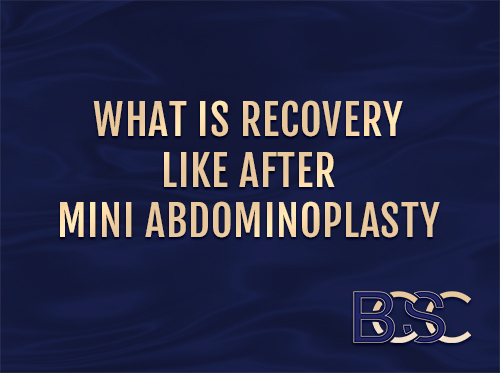Everything You Need to Know about Diastasis Recti
Medically DRAM (Diastasis of the rectus abdominis muscle) is defined as an inter-rectus distance (IRD) of 22 mm, three centimetres above the umbilicus, measured in a relaxed state. The connective tissue between the muscle is called the linea alba, and it can get stretched by pregnancy or weight gain leading to muscle separation.
The degree of separation varies from one individual to the next. In some cases, the separation is minimal and barely visible externally. In others, it’s an observable pouch of loose skin and fat that hangs outward from the belly.

Abdominal muscle separation
Regardless of the severity of diastasis recti abdominis, patients experiencing it will also go through additional symptoms associated with abdominal wall weakness. These can seriously hamper the ** by making daily activities like exercise or simply sitting up and lying down **.
The condition is abbreviated as DRAM. Some alternate names of the condition include:
- Rectus diastasis
- diastasis recti abdominis
- Rectus divarication
- Abdominal separation
- Split abdominal muscles
- Split tummy muscles

rectus abdominis muscles
What is diastasis recti abdominis?
We know now that diastasis recti is caused by stretching of the connective tissue between the abdominal muscles. But what stretches that tissue out in the first place? Knowing the answer will lead us to the most common causes of how diastasis recti occurs.
The linea alba is a flexible band of tissue. It’s designed to stretch or shrink to accommodate changes in the size of your belly. However, when it is stretched too far, during episodes of weight gain or pregnancy, it loses the ability to spring back into place.
The two groups most commonly experience diastasis recti are pregnant women and newborns. Let us consider the latter first since it is of less concern. Newborn infants sometimes display signs of diastasis recti immediately after birth. However, this is only because their muscles are not yet fully developed. In most cases of diastasis recti in babies, the condition resolves itself within the first two years of life.
Pregnant women are not as lucky as their babies. As many as two-thirds of all pregnancies result in abdominal separation heal diastasis recti. Carrying a growing foetus in the womb puts a lot of pressure on the abdominal wall. Though a small fraction of diastasis recti cases in pregnant women resolve themselves naturally, it’s more common for it to require treatment.
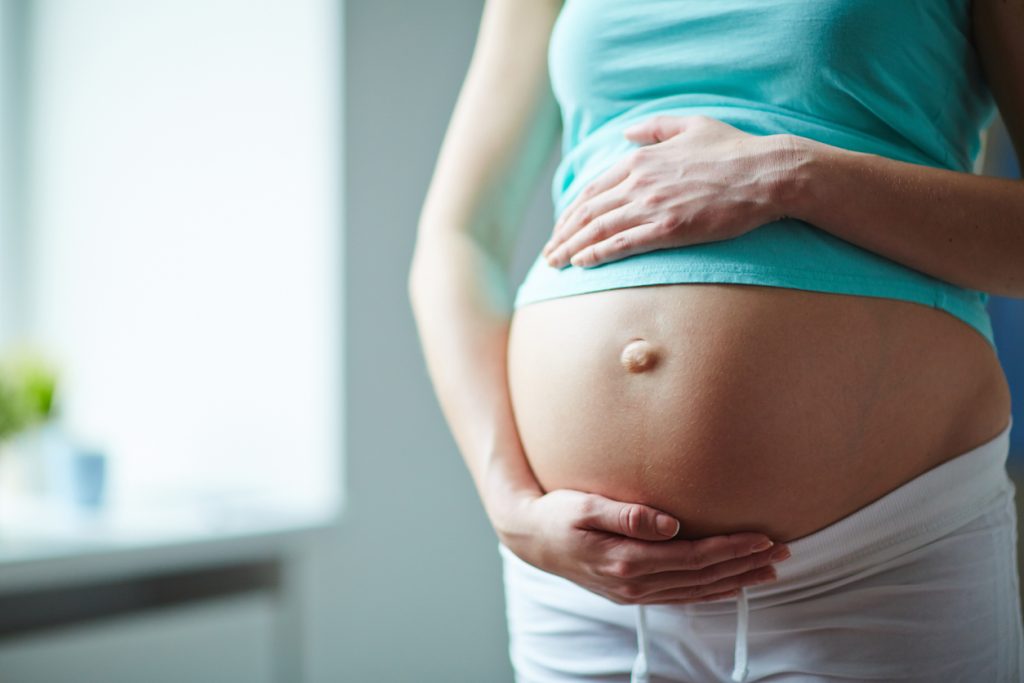
Third trimester pregnant woman
There are certain risk factors that make it more likely for a pregnant woman to experience diastasis recti. They are:
- Having multiple pregnancies close together
- Being 35 years or older
- Delivering a high birth-weight infant
- Carrying multiple babies (twins, triplets, etc.)
- Being slightly built
- Over-exerting the abdominal muscles
- Vaginal birth
While abdominal separation is commonly associated with pregnancies, diastasis recti is not exclusively a women’s problem. Men can experience diastasis recti as well. Being overweight, irrespective of gender, has been proven to be another common cause of abdominal separation.
Symptoms of Diastasis Recti
In most cases, you can tell if a patient is suffering from diastasis recti just by looking at their belly. The separation in the abdominal muscles leads to the formation of a loose pouch of skin and fat around the belly button area. When this person contracts their ab muscles, a visible cone or dome pops up in the affected area rather than the muscles tightening. Diastasis recti make the tissue around the belly button feel soft and jelly-like.
Diastasis recti can also lead to other health complications. These include:
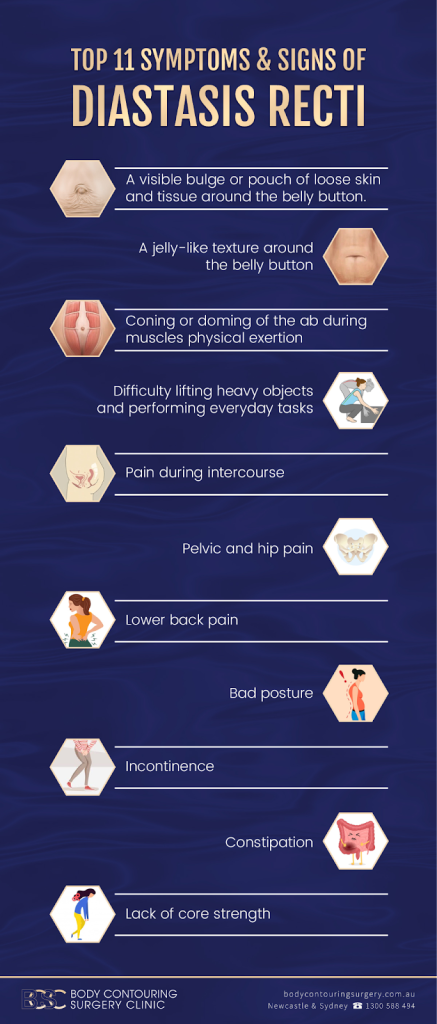
Infographic of top 11 symptoms of diastasis recti
Incontinence
Pregnant women will attest that carrying a baby wreaks havoc on their bladder control. But diastasis recti can make urinary incontinence persist even after pregnancy. The weakened abdominal floor muscles can no longer pull their weight alongside the pelvic floor muscles, leading to incontinence. Diastasis recti can cause urine leakage while laughing, coughing, sneezing, or exercising.
Hernia
One of the most serious complications arising from diastasis recti is a hernia. Since the condition weakens your abdominal wall, it can progress to the point that internal tissue pushes through, causing a bulge in your abdomen.
Lower Back Pain
When one group of muscles weakens, other muscles compensate to pick up the slack. In cases of diastasis recti, the abdominal muscle separation means the front of your core can no longer carry the weight of your body. This affects your posture. To make up for this, your back muscles constantly try to hold your core erect. This can lead to undue strain on your back muscles and lower back pains.
Digestive Problems
Your abdomen is the site of your digestive system. So it’s only natural that the separation of your abdominal muscles leads to digestive problems. Other digestive problems that can be linked to diastasis recti are diarrhoea and bloating. A 2021 study also found that abdominal pains were among the most common self-reported symptoms of women with diastasis recti (ref 1).
Weak Core Muscles
Since diastasis recti negatively affect your ability to contract your abdominal muscles, it will leave you with a weak core. This inability to support the body’s weight will lead to discomfort and poor posture. This can seriously affect your lifestyle and physical therapy, as weak core muscles will prevent you from performing certain exercises.
Pelvic Organ Prolapse
Because diastasis recti also weakens the pelvic floor along with the other rectus abdominis muscles, there is a danger of prolapse. This occurs when the pelvic floor muscles cannot support the weight of the internal organs situated in the pelvis. These organs include the rectum, uterus, vagina, urethra, and bladder. When the muscles give way beneath their weight, any of these organs can bulge into the vagina, causing a pelvic organ prolapse.
How to Tell If You Have Diastasis Recti
If you think your pregnancy resulted in abdominal separation, or if you have been experiencing any combination of the symptoms mentioned above, there is a ** test you can perform from the ** of your home.

Checking for muscle separation
Steps to Check for Diastasis Recti at Home
- Step 1: Lie on your back
- Step 2: Bend your knees and rest your feet flat on the floor
- Step 3: Place your right hand under your head for support, and your left hand across your midsection
- Step 4: Raise your shoulders off the ground as if you are doing a stomach crunch
- Step 5: When your shoulders are off the ground, tighten and contract your pelvic floor
- Step 6: Feel for a gap between your abdominal muscles using your left hand
The results of this self-examination are reliable in detecting cases of diastasis recti. A gap along the line of your belly button that is more than one finger in width is a sign of abdominal separation.
Other Means of Diagnosing Diastasis Recti
Apart from this method of self-examination, doctors can also conduct a physical exam and tests to check if you are suffering from diastasis recti. Some tests that can be used by physical therapist to check for abdominal separation are:
- Ultrasonography (Ultrasound imaging)
- Computed Tomography (CT scans)
- Magnetic Resonance Imaging (MRI scans)
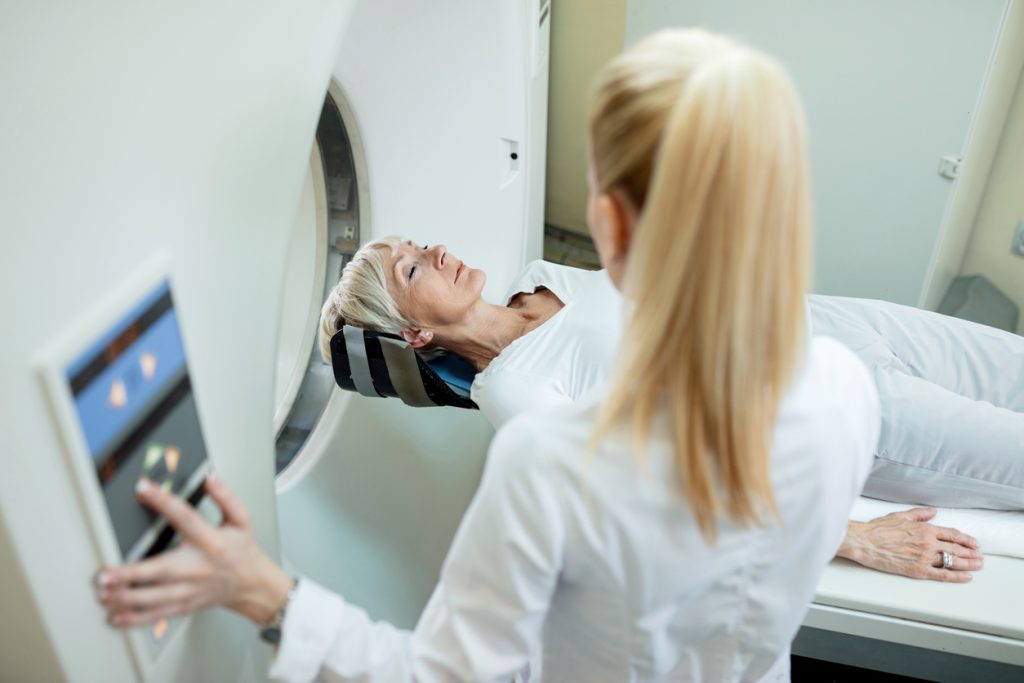
MRI scan
Treatment Options For Diastasis Recti
If you are fortunate to have only a slight separation, your diastasis recti can heal naturally after pregnancy. However, this is far from guaranteed for every case of abdominal separation. More frequently, you will need to pursue some form of treatment to bring the rectus abdominis back together. Thankfully, there are multiple treatment options for diastasis recti, ranging from conservative approaches to surgical remedies.
Conservative Care
Before choosing to go in for surgery, pursuing more conservative forms of treatment for diastasis recti is advisable. A few months of remedial action can go a long way in repairing your abdominal muscles. The goal is to remove factors that worsen diastasis recti from your lifestyle and help you lose excess weight.
New mothers should ask their doctors for physiotherapist recommendations since postpartum exercise programmes have been found to be effective. With an exercise program, wearable supports like belly bands can help hold your abdominal muscles in place. This also alleviates some of the symptoms of diastasis recti.
Surgery on the rectus abdominis muscles
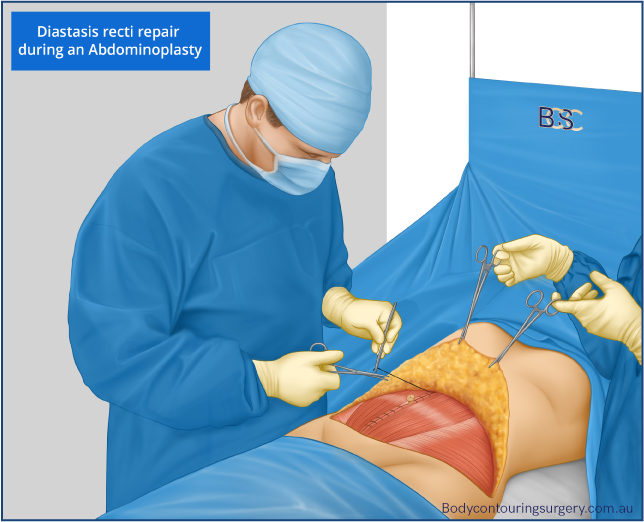
Abdominal muscle repair
Diastasis recti that cannot be healed through conservative means require surgery. An abdominoplasty, also known as a tummy tuck surgery, is an operation to fix abdominal separation. During this surgery, the rectus abdominis are returned to their original position by restructuring the linea alba with supporting sutures.
An abdominoplasty will leave behind a scar and has the potential to cause other health complications as well. Pregnant women should consult closely with their doctors to see if they are at any risk of suffering these complications after an abdominoplasty. If you see yourself having another pregnancy in the future, then it is best to wait until your last pregnancy before getting this surgery.
Overcoming diastasis recti is extremely rewarding. Once the condition is cured, people experience a higher **. Abdominoplasty surgery has been shown to help with issues like incontinence and back pains. In some cases, it can even help with posture.
In July 2021, the Australian Government announced that it was subsidising abdominoplasty surgery for women experiencing diastasis recti. To learn more about which patients are eligible for the subsidy, refer to the 30175 Medicare Item Number factsheet.
Sources
- Laura Fuentes Aparicio, Montserrat Rejano-Campo, Gráinne Marie Donnelly, Victoria Vicente-Campos (2021) “Self-reported symptoms in women with diastasis rectus abdominis: A systematic review” Journal of Gynecology Obstetrics and Human Reproduction, Volume 50, Issue 7, September 2021
Links
- mbsOnline.gov.au. March 29, 2022 “New MBS item 30175 for abdominoplasty” [Accessed June 23, 2023]



